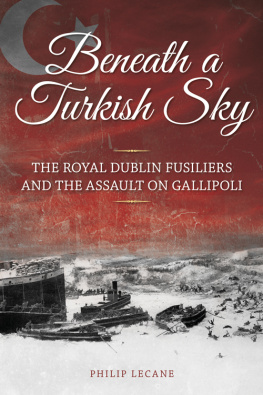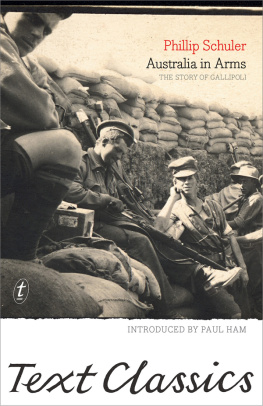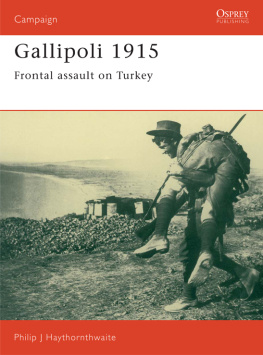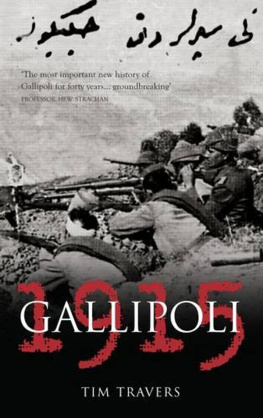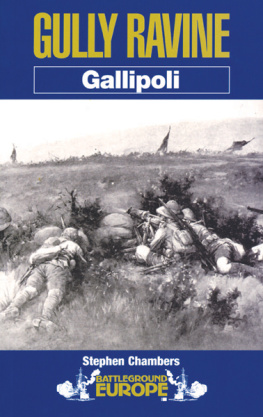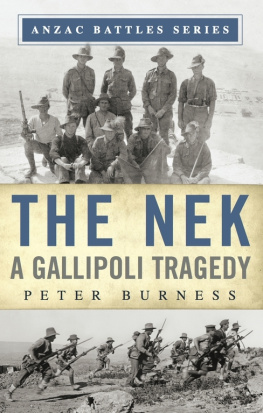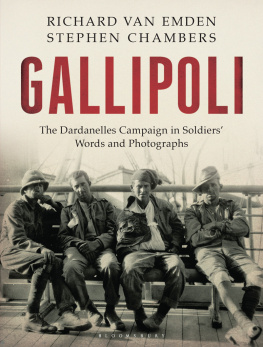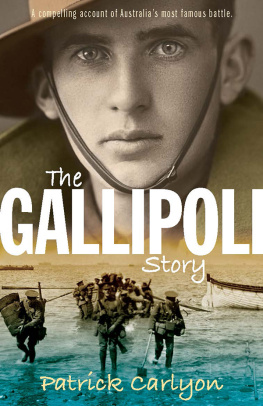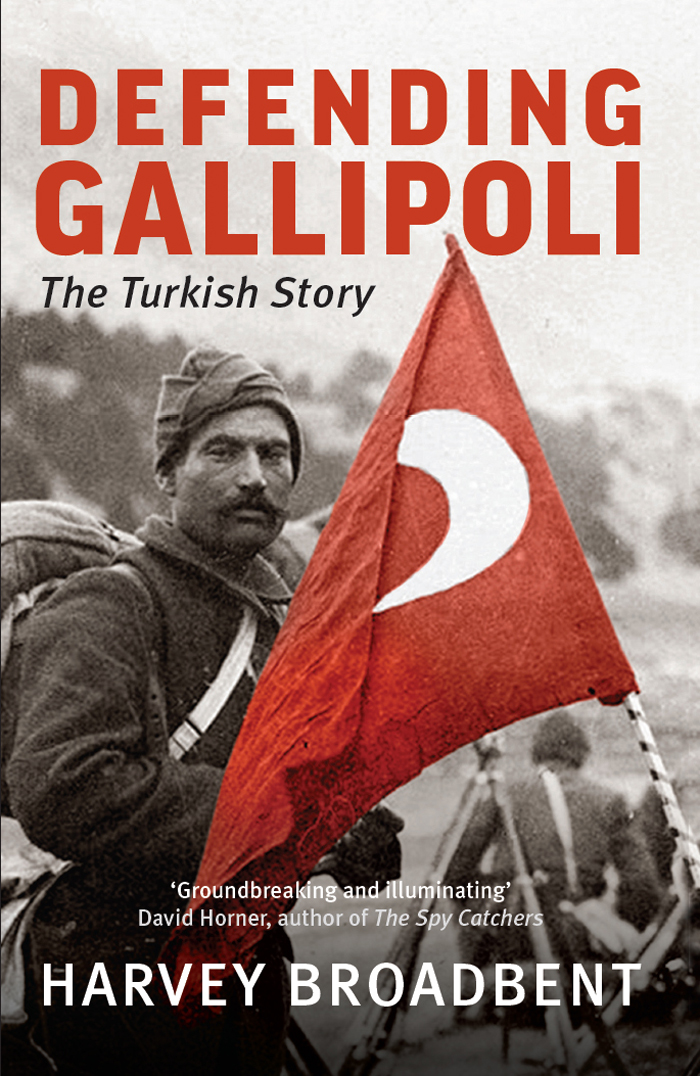DEFENDING
GALLIPOLI
The Turkish Story
DEFENDING
GALLIPOLI
The Turkish Story
HARVEY BROADBENT

MELBOURNE UNIVERSITY PRESS
An imprint of Melbourne University Publishing Limited
1115 Argyle Place South, Carlton, Victoria 3053, Australia
mup-info@unimelb.edu.au
www.mup.com.au
First published 2015
Text Harvey Broadbent, 2015
Design and typography Melbourne University Publishing Limited, 2015
This book is copyright. Apart from any use permitted under the Copyright Act 1968 and subsequent amendments, no part may be reproduced, stored in a retrieval system or transmitted by any means or process whatsoever without the prior written permission of the publishers.
Every attempt has been made to locate the copyright holders for material quoted in this book. Any person or organisation that may have been overlooked or misattributed may contact the publisher.
Cover design by Philip Campbell Design
Typeset by Megan Ellis
Printed in Australia by McPhersons Printing Group
National Library of Australia Cataloguing-in-Publication entry
Broadbent, Harvey, 1947 author.
Defending Gallipoli: The Turkish Story/Harvey Broadbent.
9780522864564 (paperback)
9780522864571 (ebook)
Includes bibliographical references and index.
Turkey. OrduHistoryWorld War, 19141918.
World War, 19141918CampaignsTurkeyGallipoli Peninsula.
Gallipoli Peninsula (Turkey)History, Military.
940.426
CONTENTS
For the memory of those soldiers whose stories have not been told and who perished by the folly of others.
PREFACE
This book is the result of six years of intensive research in Turkish archives and translations of selected Turkish material. I published a much more detailed account with extensive examples of translated documents in a reference book, Gallipoli: The Turkish Defence. Much of the original material itemised in that book I leave to be interpreted by military historians and tacticians. Defending Gallipoli, on the other hand, is designed to provide a flowing story of the Turks at Gallipoli and how they came to successfully defend that small area of their homeland against the might of imperial British and French naval and land forces. As space and time prevents a comprehensive history from both sides of the conflict, here we view the campaign directly from the Turkish perspectivefrom the other side of no-mans land.
The details of the Turkish defence at Gallipoli offer strong evidence for a number of assertions about the Turkish operations and a greater understanding of how they contributed to the outcomes at Gallipoli. My observations of these are frequently summarised at the end of chapters and in the short Reflections section at the end. Both Turkey and Australia appreciate the importance of the Gallipoli Campaign for their national identities and ideals. So this book is partly a response to that common interest and the need to provide a factual account of events not covered in earlier Gallipoli accounts.
Most books about the conflict, many admirable in their own strengths, have been generally confined to the campaign from the Allied perspective. This book describes the major Turkish operations at Gallipoli that have, apart from the notable academic work of American military historian Edward Erickson, been missing from books about the campaign. Hopefully it helps fill that gap and brings about more understanding of how the operations of the Ottoman forces affected the outcomes of this campaign. By detailing the operations of the other side we gain a more comprehensive understanding of the factors that led to the failure of the Anzacs and their allies at Gallipoli.
It was only after 2003 that I gained access to The Turkish General Staff Military History and Strategic Institute archives, known by the Turkish acronym ATASE. Here I found a treasure trove of primary source material, and the earliest finds were used in my previous book Gallipoli: The Fatal Shore (Penguin-Viking, 2005). Several years on I have accessed the archives further and sourced a wider range of Turkish sources. This work was made possible by a partnership between Australian and Turkish organisations to mark the centenary of the Gallipoli Campaign. They are the result of the Gallipoli Centenary Research Project established by Macquarie University and myself with partners, the Australian War Memorial, Australian Research Council and Turkeys Middle East Technical University (METU). Between 2007 and 2012, the project investigated and translated previously unexamined but comprehensive Turkish records of the campaign.
Once research began a huge volume of fascinating material emerged. It was a double-edged sword, though, as it would take a decade or more to comprehensively work through and translate the documents. Priority had to be given to the main strategically and tactically important conflicts of the campaign and, being an Australian-history project, the actions faced by ANZAC forces in the campaigns major events took precedence. This book therefore focuses on six major stages: initial Ottoman defence tactics, their dispositions on the Gallipoli Peninsula, the response to the landings, the ensuing battle for the ANZAC sector in May, the August Offensive, and the Allied evacuation.
British sectors are not ignored, with chapters covering archival material relating to the British landings at Cape Helles and the Suvla Bay operations included. For reasons of space, though, previously published material from the Allied side is only briefly summarised in order to put the Ottoman actions into context and appears on a sans serif font. Readers can go to one or more of the one hundred-plus English-language books published about Gallipoli since 1915 to read alongside this one (see Select Bibliography). For the same reason, it has not been possible to describe and assess the impact on the outcomes at Gallipoli of Ottoman logistics (supplies, transport, etc.), as important as they are. The concentration is on battlefield events and operations.
The Ottoman documents used to tell the Turkish story include, among several types, the most useful divisional, regimental and battalion war diaries (called in Turkish, harp cerideler or war registers), battlefield reports and signals, Ottoman War Ministry communications, records of prisoner interrogations, aircraft logs and diaries, and First World War Turkish press reports. Other sources included published and unpublished memoirs and personal war diaries. The result is this narrative of events at Gallipoli completely from the Turkish perspective. My hope is to satisfy readers interested in furthering their understanding and knowledge of the Gallipoli Campaign, and how the Ottomans achieved their success at Gallipoli, how their commanders and troops responded to the invasion of their homeland and were able, under great pressure, to resist, persevere and ultimately succeed.
Harvey Broadbent
Sydney, 2015
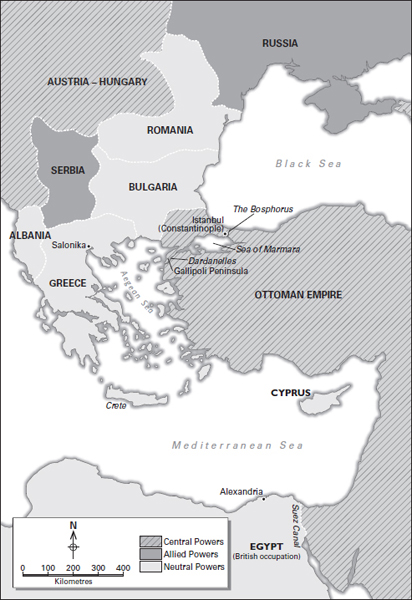
Map 1 The Eastern Mediterranean in 1914
NOTE ON PRONUNCIATION AND DEFINITIONS
Apart from additional letters with accents, the modern Turkish alphabet has the same letters as the English alphabet. In some cases they are pronounced differently as follows:



